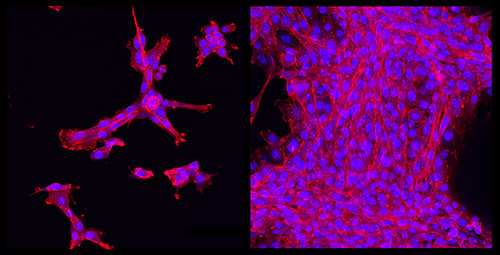![Fluorescence microscopy images showing cell adhesion, growth, and spread within a click alginate hydrogel over the course of three days. [Wyss Institute at Harvard University]](https://genengnews.com/wp-content/uploads/2018/08/May4_2015_ClickChemistryHydrogel1920323117-1.jpg)
Fluorescence microscopy images showing cell adhesion, growth, and spread within a click alginate hydrogel over the course of three days. [Wyss Institute at Harvard University]
Hydrogel—the name itself suggests something that is almost as innocuous as water. But many hydrogels are assembled from chemical components that congeal into something that is less than truly biocompatible. A new kind of hydrogel, however, promises to ensnare cells and bioactive molecules in a mesh that is both safe and strong. This hydrogel, say its creators, is a “click alginate.” And it may have a range of drug-delivery, cell-culture, and tissue-engineering applications.
Alginate hydrogels are made up of the polysaccharide naturally occurring in brown seaweed. The rate at which the three-dimensional, internal molecular structure of alginates will degrade over time can be precisely tuned, which enables engineers to rationally design and control the release of drug molecules encapsulated in the gel.
To date, however, alginate hydrogels have lacked chemoselectivity. As a result, they have a tendency to damage the cells and molecules they encapsulate. Damage can accumulate during the encapsulation process or through unintended reactions with the chemical reagents in the hydrogel, making therapeutic design and delivery in the clinic very difficult.
A more chemoselective alginate hydrogel has been described by scientists based at the Wyss Institute. These scientists, led by David Mooney, Ph.D., and Neel Joshi, Ph.D., say that their alginate hydrogel can be assembled from just a few reliable, chemoselective reagents.
The scientists describe their work in the May issue of Biomaterials, in an article entitled, “Versatile click alginate hydrogels crosslinked via tetrazine–norbornene chemistry.”
“[We] introduce tetrazine and norbornene groups to alginate polymer chains and subsequently form covalently crosslinked click alginate hydrogels capable of encapsulating cells without damaging them,” wrote the article’s authors. “The rapid, bioorthogonal, and specific click reaction is irreversible and allows for easy incorporation of cells with high post-encapsulation viability.”
The scientists assert that their hydrogel presents a practical platform for long-term, stable encapsulation of bioactive materials. And they add that it is robust enough to be used in a variety of ways, which is exciting due to the variety of therapeutic drugs that are made from proteins.
“It's injectable, so it can be used to deliver cells or drugs to specific places in the body such as a location that has suffered a wound or has been invaded by a tumor,” said Joshi. “And we are already using it for lots of different things in the laboratory due to how easy it is to synthesize.”
Other types of hydrogels are much more cumbersome to synthesize, according to the study's first author, Rajiv Desai, who is a researcher at the Wyss Institute pursuing his Ph.D. from Harvard's School of Engineering and Applied Sciences. In contrast, the click alginate hydrogel can be created by a simple and fast combination of two simple solutions—similar to an epoxy. And once the gel is formed, the click chemistry reactions are irreversible, resulting in a chemoselective hydrogel primed for use as a therapeutic scaffold.
“The click alginate hydrogel can be modified after gelation to display cell adhesion peptides for 2D cell culture using thiol-ene chemistry,” the authors of the Biomaterials article continued. “Furthermore, click alginate hydrogels are minimally inflammatory, maintain structural integrity over several months, and reject cell infiltration when injected subcutaneously in mice.”
The scientists also indicated that the swelling and mechanical properties of the click alginate hydrogel can be tuned via the total polymer concentration and the stoichiometric ratio of the complementary click functional groups. “One of the many things people like to do with hydrogels is to modify them for different purposes,” explained Desai. “With our new method, if you wanted to add a fluorescent dye, peptide, or protein to the new click alginate, you could do so within one minute—a truly unprecedented rate.”


